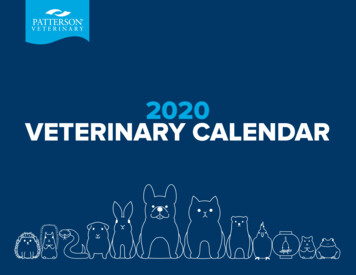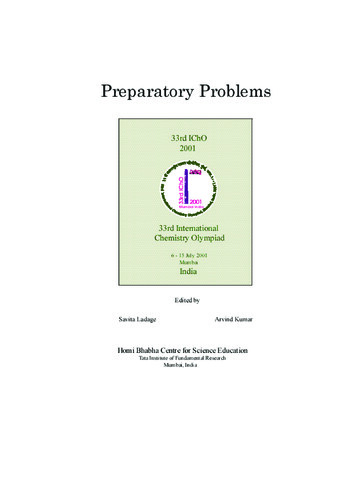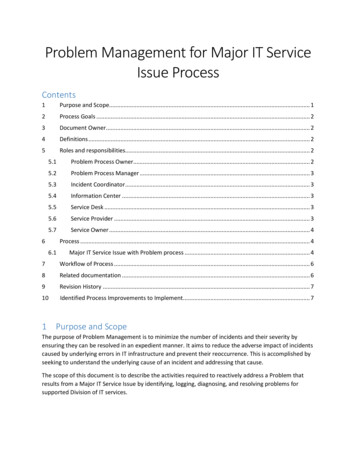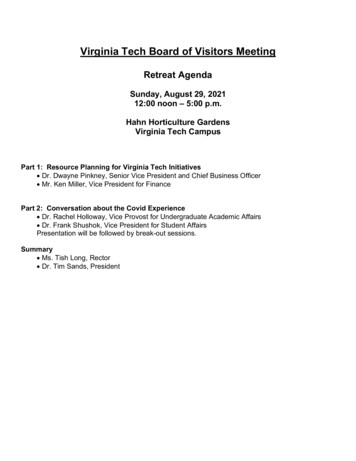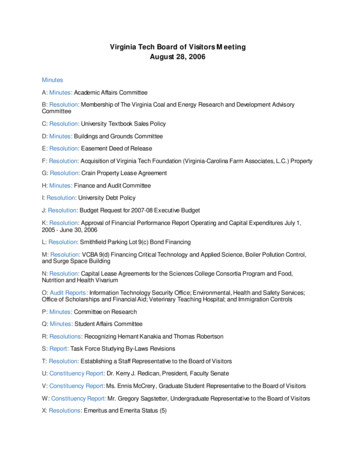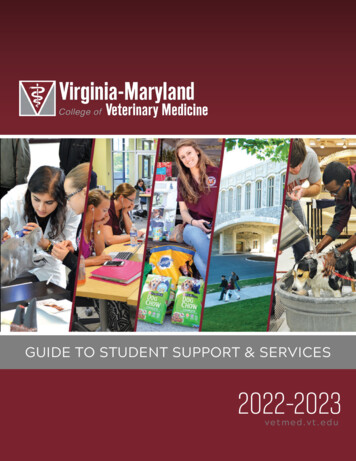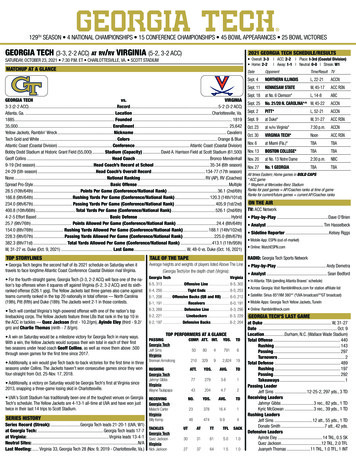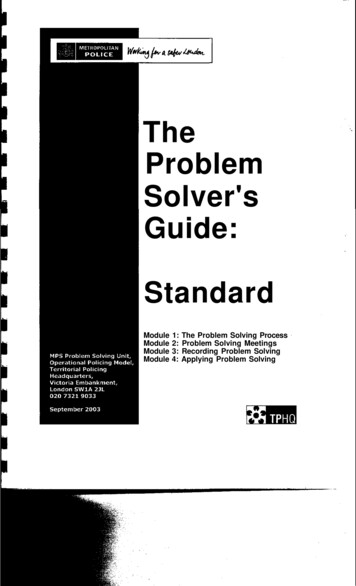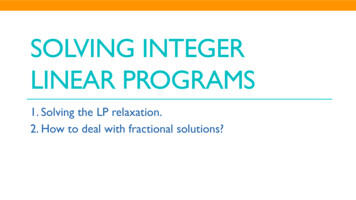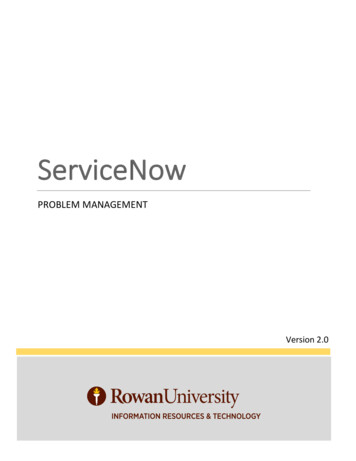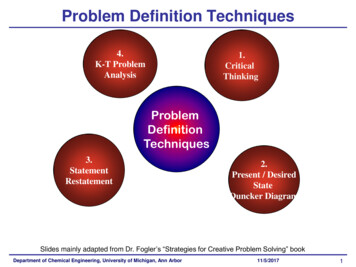
Transcription
Problem Definition Techniques4.K-T Techniques3.StatementRestatement2.Present / DesiredStateDuncker DiagramSlides mainly adapted from Dr. Fogler’s “Strategies for Creative Problem Solving” bookDepartment of Chemical Engineering, University of Michigan, Ann Arbor11/5/20171
Problem Definition Check problem statement with Socraticquestioning (Critical Thinking Algorithm):1. Where did the problem originate?2. Who posed the problem statement? Your boss?Their boss? Colleague? Client?3. Can that person explain their reasoning?4. Are the reasoning and assumptions valid?5. Has that person considered different viewpoints?6. What are implications and consequences ofassumptions?Socratic Questioning is at the Heart ofCritical Thinking
Problem Definition TechniquesProblemDefinitionTechniques2.Present / DesiredStateDuncker DiagramDepartment of Chemical Engineering, University of Michigan, Ann Arbor10/31/20173
Duncker DiagramsOK Not toAchieve DesiredStateAchieve DesiredStatePossible Paths to Desired StatePath 1Path 2Path 3Solutions to ImplementPaths to Desired StateSolution 1WhattodoSolution 3Possible Paths to MakeOK not to Achieve Desired StatePath 1Howto doitPath 2Path 3Solutions to ImplementPaths Not to Achieve Desired StateSolution 1Solution 3Solution 2Solution 2Desired StateNew Problem StatementDepartment of Chemical Engineering, University of Michigan, Ann Arbor10/31/20174
To Market, To MarketThe Situation: Toasty O’s was one of the hottest selling cereals whenit first came on the market. However, after several months, salesdropped. The consumer survey department was able to identify thatcustomer dissatisfaction, as expressed in terms of taste, was relatedto the age of the cereal. Consequently, management determinedthat they must streamline the production process to get the cerealon the store shelves faster, thus ensuring a fresher product.Engineering had quite a time with this problem - there wasn’t muchslack time that could be removed from the process to accomplishthe goal. Of the steps required to get the product on the shelves(production, packaging, storage, and shipping) production was oneof the fastest. However, plans for building plants closer to the majormarkets were considered as was trying to add more trucks to get thecereal to market faster.Department of Chemical Engineering, University of Michigan, Ann Arbor10/31/20175
To Market, To MarketSales of Toasty O’s are dropping.Consumer surveys have indicated adissatisfaction with a stale taste.Perceived Problem:“Streamline the production process toget the cereal on the store shelvesfaster, thus ensuring a fresher product.”However, production was one of thefastest steps in getting the product tomarket.Second Perceived Problem:Get the Cereal to Market FasterGet Cereal toMarket fasterBuild More PlantsCloser to MarketLocationsImproveTransportationSystemCharter jets for trips 1000 miHire former raceCar driversIgnore speedlimitsDepartment of Chemical Engineering, University of Michigan, Ann Arbor10/31/20176
To Market, To MarketSales of Toasty O’s are dropping.Consumer surveys have indicated adissatisfaction with a stale taste.Make it OK NOTto get cereal tomarket fasterPerceived Problem:“Streamline the production process toget the cereal on the store shelvesfaster, thus ensuring a fresher product.”StopMakingCerealHowever, production was one of thefastest steps in getting the product tomarket.Thus, the following optionswere considered: Build plants closer to market Add more trucksMake CerealStay FresherLongerAdd a chemical to slowdown the spoilingreactionConvinceCustomers thatStale GoodMake boxes tighterand more impermeableto air andmoistureThese options require a major capital investment.Department of Chemical Engineering, University of Michigan, Ann Arbor10/31/20177
To Market, To MarketOriginal StatementHow to get cereal to market faster.Make it OK NOTto get cereal tomarket fasterThe real problem was that the cerealwas not staying fresh long enough,not that it wasn’t getting to market fastenough.StopMakingCerealNew Problem StatementHow to make boxes tighter and todetermine appropriate additive toslow down the spoiling reactionMake CerealStay FresherLongerAdd a chemical to slowdown the spoilingreactionDepartment of Chemical Engineering, University of Michigan, Ann ArborConvinceCustomers thatStale GoodMake boxes tighterand more impermeableto air andmoisture10/31/20178
To Market Example – Dunker approach9
Example: Teaching Problem: kindergarten teacher burned out from 25 yearsof teaching.Quit teaching:1. Find a new job:1. Office manager.2. Sales person.2. Retire.Make it OK not to quit:1. More leisure time:1.2.teach alternate terms,teach half days.2. Lower stress level:1.2.teach different grade,get more control over content.
Problem Definition Techniques4.K-T ProblemAnalysis1. mentRestatementDepartment of Chemical Engineering, University of Michigan, Ann Arbor2.Present / DesiredStateDuncker Diagram10/31/201711
Problem Definition statementDepartment of Chemical Engineering, University of Michigan, Ann Arbor10/31/201712
Statement Restatement TechniquePerceived ProblemMake Opposite StatementRestatementGeneralizeRelax ConstraintsRestatementFinal ProblemStating Statementthe Real ProblemDepartment of Chemical Engineering, University of Michigan, Ann Arbor10/31/201713
Problem Statement Triggers1. Vary the stress pattern—try placing emphasison different words and phrases.2. Choose a term that is defined explicitly andsubstitute the explicit definition in each placethat the term appears.3. Make an opposite statement, changepositives to negatives, and vice versa.Department of Chemical Engineering, University of Michigan, Ann Arbor10/31/201714
Problem Statement Triggers4. Change “every” to “some,” “always” to“sometimes,” “sometimes” to “never,” and viceversa.5. Replace “persuasive words” in the problemstatement such as “obviously,” “clearly,” and“certainly” with the argument it is supposed tobe replacing.6. Express words in the form of an equation orpicture, and vice versa.Department of Chemical Engineering, University of Michigan, Ann Arbor10/31/201715
Using the TriggersOriginal Problem Statement: Cereal not getting to market fastenough to maintain freshnessTrigger 1: Vary Stress PatternRead the sentence with emphasis on each of these words – whatquestions do they suggest? CerealGettingMarketFreshnessDepartment of Chemical Engineering, University of Michigan, Ann Arbor11/2/201716
Using the TriggersOriginal Problem Statement: Cereal not getting to market fastenough to maintain freshnessTrigger 1: Vary Stress Pattern Cereal not getting to market fast enough to maintain freshness .(Do other products we have get there faster?) Cereal not getting to market fast enough to maintain freshness.(Can we make the distance/time shorter?) Cereal not getting to market fast enough to maintain freshness.(How can we keep cereal fresher, longer?)Department of Chemical Engineering, University of Michigan, Ann Arbor11/2/201717
Using the TriggersOriginal Problem Statement: Cereal not getting to market fastenough to maintain freshnessTrigger 3: Make an Opposite Statement How can we find a way to get the cereal to market so slowly that itwill never be fresh?(Makes us think about how long we have to maintain freshness andwhat controls it?)Department of Chemical Engineering, University of Michigan, Ann Arbor10/31/201718
Using the TriggersOriginal Problem Statement: Cereal not getting to market fastenough to maintain freshnessTrigger 4: Change “every” to “some” Cereal is not getting to market fast enough to always maintainfreshness.(This change opens new avenues of thought. Why isn’t our cerealalways fresh?)Department of Chemical Engineering, University of Michigan, Ann Arbor10/31/201719
Using the TriggersOriginal Problem Statement: Cereal not getting to market fastenough to maintain freshnessTrigger 5: Replace “persuasive” wordsThe problem statement implies that we obviously want to get thecereal to market faster to maintain freshness.Thus, if we could speed up delivery freshness would be maintained.Maybe not! Maybe the store holds it too long. Maybe it’s stalebefore it gets to the store.(This trigger helps us challenge implicit assumptions made in theproblem statement.)Challenge assumptions: “Clearly” suggests an assumption. Maybe cereal doesn’t get to store fresh? Maybe the store holds it too long. Maybe it is stale before it leaves the factory.Department of Chemical Engineering, University of Michigan, Ann Arbor11/2/201720
Using the TriggersOriginal Problem Statement: Cereal not getting to market fastenough to maintain freshnessTrigger 6: Express the words in the form of an equation Freshness is inversely proportional to the time since the cereal wasbaked, i.e. Freshness k Time Since Cereal Baked What does the proportionality constant, k, depend upon?storage conditions, packaging, type of cereal, additives, etc.Department of Chemical Engineering, University of Michigan, Ann Arbor10/31/201721
Asprin CoatingThe Situation: To many people, taking aspirin tablets is afoul tasting experience. A few years ago, a number ofcompanies making aspirin decided to do something aboutit. The instructions given by the manager to his staff tosolve the perceived problem were: “Find a way to put apleasant tasting coating on aspirin tablets.” Sprayingthe coating on the tablets had been tried, with very littlesuccess. The resulting coating was very non-uniform andthis led to an unacceptable product. Let's apply the triggersto this problem.Department of Chemical Engineering, University of Michigan, Ann Arbor10/31/201722
Asprin CoatingThe instructions given bythe manager to his staff tosolve the perceived problemwere:“Find a way to put apleasant-tasting coating onaspirin tablets.”Department of Chemical Engineering, University of Michigan, Ann Arbor10/31/201723
“Trigger” Statements“Find a way to put a pleasant tasting coating on aspirin tablets.”Trigger 1Emphasize different parts of the statement1. Put coating on tablet.Trigger 3Make an opposite statement2. Take coating off tablet.Department of Chemical Engineering, University of Michigan, Ann Arbor10/31/201724
Making an Opposite StatementThis led to one of the newer techniques for coating pills.The pills are immersed in a liquid which id passed onto aspinning disk. The centrifugal force on the fluid and thepills causes the two to separate, leaving a nice thincoating around the pill.Department of Chemical Engineering, University of Michigan, Ann Arbor10/31/201725
Problem Definition Techniques4.K-T ProblemAnalysis1. mentRestatementDepartment of Chemical Engineering, University of Michigan, Ann Arbor2.Present / DesiredStateDuncker Diagram11/2/201726
Problem Definition Techniques4.K-T nt of Chemical Engineering, University of Michigan, Ann Arbor11/2/201727
Kepner-Tregoe Decision Making StrategyComponents281.Situation appraisal.2.Problem analysis.3.Decision analysis.4.Potential problem analysis.
K.T. Problem AnalysisUseful for troubleshooting, where cause of problem is not known.Basic premise is that there is something that distinguishes what theproblem IS from what it IS NOT.The distinction column is the most important.29
K.T. Problem AnalysisISIS NOTDistinctionCauseWhatIdentify:What isproblem?What is notproblem?What differencebetween is and isnot?What ispossiblecause?WhereLocate:Where isproblem found?Where is problemnot found?What difference inlocations?Whatcause?WhenTiming:When doesproblem occur?When doesproblem not occur?What difference intiming?Whatcause?When was it firstobserved?When was it lastobserved?What differencebetween 1st, last?Whatcause?How far doesproblem extend?How localized isproblem?What is thedistinction?Whatcause?How many unitsare affected?How many notaffected?What is thedistinction?Whatcause?How much of anyone unit isaffected?How much of anyone unit is notaffected?What is thedistinction?Whatcause?ExtentMagnitude:For more details on Kepner-Tregoe problem analysis technique refer tregoe-problem-analysis/30
K.T. PA ExampleOn a new model of airplane, flight attendants develop rash on arms,hands, face (only those places). Only occurs on flights over water.Usually disappears after 24 hours. No problems on old planes overthose routes. Does not affect all attendants on these flights, but samenumber of attendants get it on each flight. Those who get rash have noother ill effects. No measurable chemicals, etc., in cabin air.31
K.T. PA Example32ISIS NOTDISTINCTIONWHAT:RashOther illnessExternal contactWHEN:New planes usedOld planes usedDifferent materialsWHERE:Flights over waterFlights over landDifferent crewproceduresEXTENT:Face, hands, armsOther partsSomething contactingface, hands and armsOnly some attendantsAll attendantsCrew duties
Picking a TechniqueFour strategies or procedures were discussed for defining the problem.Which you actually use depends on the problem and your own style.1. Problem Definition steps2. Socratic Questioning3. Dunker Diagrams4. Statement/Restatement5. Kepner-Tregoe (K.T.) Problem AnalysisYou should consciously develop some process that addresses themajor steps, which you use out of habit, to make sure that you do notend up solving the wrong problem.Be proactive: think through whether the problem statement is correctbefore solving any problem.33
Slides mainly adapted from Dr. Fogler's "Strategies for Creative Problem Solving" book. Problem Definition Check problem statement with Socratic questioning (Critical Thinking Algorithm): . Path 1 Path 2 Path 3 Possible Paths to Make OK not to Achieve Desired State Solution 1 . that the term appears. 3. Make an opposite statement .
